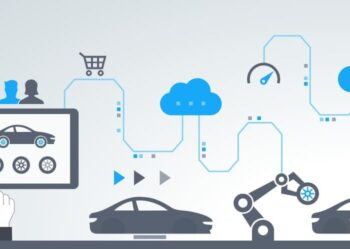The Muda or the 7 wastes that every Lean company must fight

We’ve already talked to you about the different tools and methodologies in Lean through the 5S workgroup, the Jidoka, the Poka Yoké and the Monozukuri. Today we’re going to look together at the value of using Muda to fight against all forms of waste, allowing companies to identify everything that has no value or does not add value and for which the customer will not pay.
Definition of Muda :
One of the key elements to move a company forward is to be able to identify and eliminate waste.
Are the processes in place adequate? Is there a bottleneck on the production line? Are the employees productive enough? These are all questions that can be asked in Lean Manufacturing.
Muda, which means waste, is intended to improve the company’s processes and refers to inefficiencies in the processes that must be identified in order to reduce or eliminate them entirely.
Eliminating waste is one of the objectives of any lean system. Muda identifies anything that has no value or does not add value and for which the customer will not pay.
Identify waste for disposal
There are 2 main forms of waste: obvious waste and hidden waste.
Often hidden waste is the most impactful because it is not even considered and therefore easily grows to the point of being more important than obvious waste.
Hidden waste is like an iceberg: you see the tip but you don’t know that there is a much larger surface underwater.
In order to fight against waste and therefore waste, it is essential to identify the main steps to implement.
- Make waste visible.
- Become aware of waste.
- Be responsible for waste.
- Measure waste.
- Eliminate or reduce waste
However, in order to implement these steps, it is essential to raise awareness, communicate and make everyone responsible for the analysis and the actions to be taken.
The different wastes and solutions to reduce or even eliminate them
-
The waste of overproduction (the biggest waste in general)
Overproduction waste is often overlooked by companies that view extra inventory as an asset rather than a liability. However, the costs of running machinery or services above the rate of production can be a hidden waste that these companies don’t always think about. Coupled with the additional costs of holding excessive inventory or not being able to sell that inventory after a certain period of time, this can create further waste for a company.
This type of waste usually comes from producing more than is necessary, producing faster than is necessary, or holding large volumes of inventory unnecessarily.
However, solutions exist, for example, just-in-time production systems create products at the rate they are needed, while pull production systems can be used to adapt production to demand. Finally, more accurate sales projections can reduce overly high targets and rebalance production priorities.
-
Waste of available time (often associated with waiting)
Waiting happens in every business and can be as simple as being late for a meeting. In an industrial environment, the problem can be the result of physical problems such as damaged machinery or delayed raw materials. In these environments, it is important to analyse the cost of waste and calculate how long it would take to make a capital injection into new equipment pay off.
This waste is represented by worker downtime, machine downtime, idle time where projects come to a halt and budgets collapse. There are often multiple causes, such as unsynchronized processes and imbalances between production lines, overstaffing, and understaffing or poor distribution of labor on a project, or even unplanned machine stoppages or shortages of raw materials.
Here too, solutions exist and are based on process mapping and BPMN techniques, allowing managers to have an overview of the entire flow. In addition, there is increased communication with suppliers or deliveries to combat downtime and a flexible workforce capable of assuming responsibilities in different areas of the company.
-
Transport waste
Transportation means anything that is mobile and businesses are full of moving parts. These parts can be equipment, products, workers or documents.
Typical examples are the unnecessary movement of products from production to sale, the unnecessary movement of materials, products or equipment within a production process.
The cause is often related to poor route planning and distant suppliers or customers, unnecessarily complex material flows or production processes or even disorganized workplaces that fail to minimize distances or transportation costs.
To alleviate this type of waste solutions are possible such as moving aspects of production to relocate them, mapping transport flows in the production process and looking for ways to streamline and standardize these patterns, increasing digitization or reducing paperwork to reduce travel especially in business processes. Digitization and digitalization allow to generate less waste, but beware of digital pollution when the company is vigilant about its carbon footprint.
-
Waste from the processing
When you are constantly striving for perfection in a product, sometimes it gets over-treated. This often stems from a misunderstanding of why customers buy products, and what looks better to the product designer may actually turn out to be the worst for the customer if the necessary market research and customer satisfaction data are not present or considered.
This type of waste includes non-value-added processing by labor, non-value-added processing by machines, and creating unnecessary quality or depth beyond the customer’s needs.
The cause is often related to a poor understanding of the customer’s needs and product satisfaction, excessive attention to refinements and details; which can even lead to far too frequent engineering changes; or even unclear or poorly documented work instructions.
To eliminate this type of waste, solutions include the implementation of value stream mapping tools, waterfall diagrams to measure the cumulative effect of sequential variables, streamlining standard operating procedures to reduce the overall volume of documentation, and many other solutions.
-
Waste of available stock
As the name implies, inventory is a fixed asset and holding too much inventory, whether it is excessive amounts of raw materials or equipment, can slow down a business and create storage problems. Often, this form of waste is linked to overproduction, regardless of the reasons.
Indeed, overproduction, resulting in a storage problem, is often due to an imbalance in the line or to large batch sizes. However, it can also be due to poor sales or distribution performance, often related to high minimum purchasing standards or even a poor understanding of market needs or overestimation of future sales performance.
To reduce this type of waste, it is recommended to re-evaluate production targets to better meet demand and to analyze production rates of slow-moving inventory with variable demand.
-
Movement waste
Movement waste is often associated with poorly organized factories or service assemblies where workers must move around the site to gather the equipment or tools needed to complete their tasks. This includes the excessive movement of workers in the production process and the human element of production flows.
The cause of this type of waste is often related to poorly designed production facilities, non-standardized production processes, unclear material flows, or even poor operational management or training.
To eliminate this type of waste, it is recommended to set up assembly lines to minimize worker movement, to clearly categorize the availability of necessary tools or equipment, and to have effective training procedures associated with easily accessible and applicable standard operating procedures.
-
Waste from the manufacture of defective products
When we talk about the waste associated with manufacturing defective products, we often refer to the wasted processing efforts on defective products, the wasted materials on defective products, and the wasted time trying to rework or repair defective products.
Of course, anyone involved in the manufacture of physical products knows about the constant battle against defects. The world of Six Sigma is built around the idea that defect reduction is an extremely important path to quality improvement. When working on a large scale, small percentages of reduction in defective production can lead to significant financial gains.
The causes are often related to poor production process management, inadequate third-party suppliers or production elements, unclear specifications and/or insufficient manufacturing documentation.
To eliminate this type of waste, it is recommended to avoid segmenting quality control according to departments in the first place. Then it is best to use techniques such as the DMAIC process and other Six Sigma methodologies to eliminate defects. Finally, don’t forget to ensure that workers are properly trained and that standardized processes are properly followed.
As you can see, reducing waste as part of Muda can be a real growth driver for a company, both on the financial and manufacturing side.
SNECI and 70 years of experience in industrial performance improvement
Our 450 experts through our 10 subsidiaries around the world will help you improve your industrial processes, audit, training, support in rationalizing your costs … Our operational expertise with major manufacturers allows us a macro and micro approach.
We can audit you on the basis of our 360 ISA© tool, which covers all of the following areas R&D, Sustainable Development, Quality & Production, Supply Chain Management and Finance, just as we can offer you a Monozukuri workshop, Poka Yoké, … without forgetting all the expertise in industrial process improvement with our Lean Six Sigma methodology.
If you wish to be accompanied on the improvement of industrial processes, rationalization of supply chain, industrial project management, training, supplier audit… , do not hesitate to contact Laura by email laura@sneci.com or directly on our website via the contact us tab.





